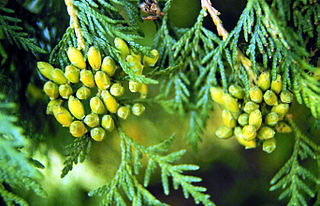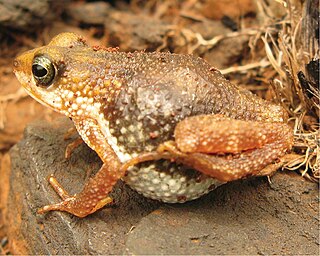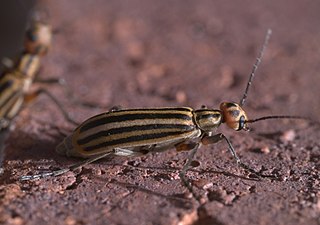
Platanus is a genus consisting of a small number of tree species native to the Northern Hemisphere. They are the sole living members of the family Platanaceae.

Platanus occidentalis, also known as American sycamore, American planetree, western plane, occidental plane, buttonwood, and water beech, is a species of Platanus native to the eastern and central United States, the mountains of northeastern Mexico, extreme southern Ontario, and extreme southern Quebec. It is usually called sycamore in North America, a name which can refer to other types of trees in other parts of the world; in the United Kingdom, for example, the name syacamore typically refers to Acer pseudoplatanus. The American sycamore is a long-lived species, typically surviving at least 200 years and likely as long as 500–600 years.

Thuja occidentalis, also known as northern white-cedar, eastern white-cedar, or arborvitae, is an evergreen coniferous tree, in the cypress family Cupressaceae, which is native to eastern Canada and much of the north-central and northeastern United States. It is widely cultivated as an ornamental plant. It is not to be confused with Juniperus virginiana.

Rubus occidentalis is a species of Rubus native to eastern North America. Its common name black raspberry is shared with other closely related species. Other names occasionally used include bear's eye blackberry, black cap, black cap raspberry, and scotch cap.

The northwestern wolf, also known as the Mackenzie Valley wolf, Alaskan timber wolf, or Canadian timber wolf, is a subspecies of gray wolf in western North America. Arguably the largest gray wolf subspecies in the world, it ranges from Alaska, the upper Mackenzie River Valley; southward throughout the western Canadian provinces, aside from prairie landscapes in its southern portions, as well as the Northwestern United States.

Cephalanthus occidentalis is a species of flowering plant in the family Rubiaceae that is native to eastern and southern North America. Common names include buttonbush, common buttonbush, button-willow, buck brush, and honey-bells.

Nimbaphrynoides is a monotypic genus of true toads from highlands in the Mount Nimba region of the West African countries of Guinea, Liberia, and Côte d'Ivoire. The sole species is Nimbaphrynoides occidentalis. Along with Nectophrynoides, Eleutherodactylus jasperi, and Limnonectes larvaepartus, Nimbaphrynoides is one of the only anurans that combine internal fertilization with ovoviviparity.

Senna occidentalis, commonly known as coffee senna, styptic weed, or septicweed, is a species of flowering plant in the family Fabaceae and is native to the southern United States of America, Mexico and South America. It is a shrub with pinnate leaves, with three to seven pairs of broadly elliptic to egg-shaped leaflets, and yellow flowers arranged in groups of two to four, with six fertile stamens in each flower. It is an aggressive, pantropical weed.

Dasymutilla occidentalis is a species of parasitoid wasp that ranges from Connecticut to Kansas in the north and Florida to Texas in the south. Adults are mostly seen in the summer months.

Clusia occidentalis is a species of fly in the family Clusiidae. It is found on the west coast of Canada and the United States of America, where it is the only known species of Clusia.

Orasema occidentalis is a species of chalcid wasp in the family Eucharitidae. The species is a parasite of Pheidole desertorum.
Bittacomorpha occidentalis is a species of phantom crane flies in the family Ptychopteridae.

Polyphylla occidentalis is a species of scarab beetle in the family Scarabaeidae. It is found in North America.
Phrictopyga occidentalis is a species of delphacid planthopper in the family Delphacidae. It is found in the Caribbean, Central America, North America, and South America.

Stizus brevipennis is a species of sand wasp in the family Bembicidae. It is found in North America.
Proctacanthus occidentalis is a species of robber flies.

Epicauta occidentalis is a species of blister beetle in the family Meloidae. It is found in North America.
Okanagana occidentalis is a species of cicada in the family Cicadidae. It is found in North America.

Martino's mole is a species of small blind mole in the family Talpidae found in eastern Thrace along the western Black Sea coast in south-eastern Bulgaria and north-eastern Turkey, mainly in the Strandzha mountain range. In Bulgaria it is found in Strandzha Nature Park. Martino's mole is named in honour of the couple Evgeniya and Vladimir Martino, key earlier Balkan mammalogists.














